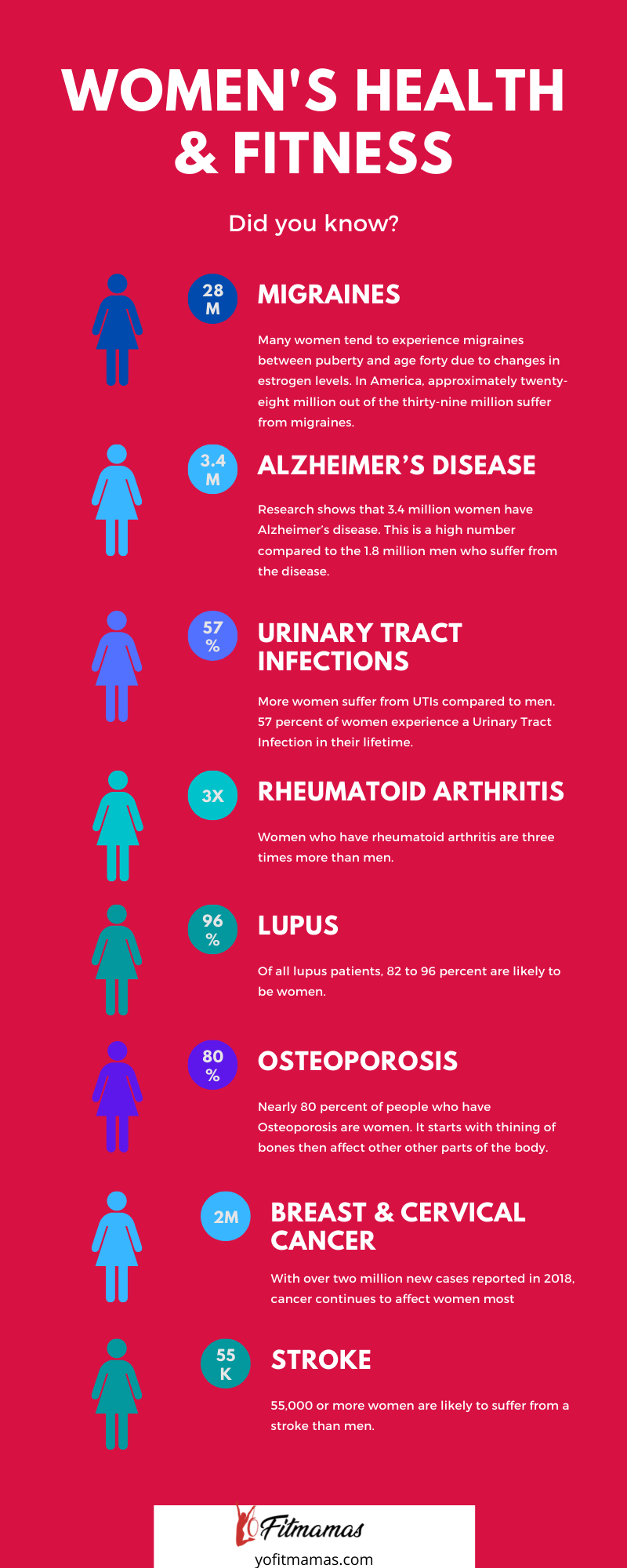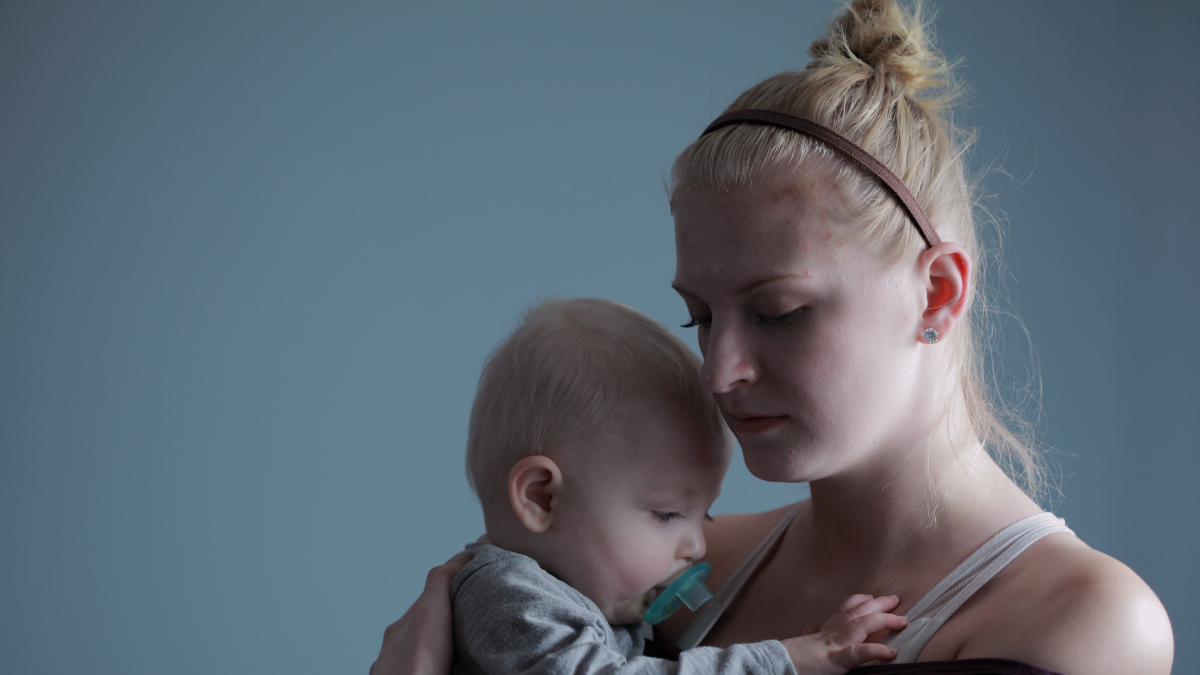We are living at a time when women empowerment is on the rise, and progress towards gender equality is promising.
However, if we women are going to improve their lives and position in society, we need a holistic approach. Women need not just to be intelligent and educated, but physically healthy, strong, and fit as well. So let’s see what we need to know about women’s health and fitness to maintain a fit future.
Women’s Health
Research has shown numerous health issues affect women more such as:
Migraines – Many women tend to experience migraines between puberty and age forty due to changes in estrogen levels. In America, approximately twenty-eight million out of the thirty-nine million suffer from migraines.
Alzheimer’s disease – Research shows that 3.4 million women have Alzheimer’s disease. This is a high number compared to the 1.8 million men who suffer from the disease.
Urinary tract infections – More women suffer from UTIs compared to men. 57 percent of women experience a Urinary Tract Infection in their lifetime.
Multiple sclerosis – Studies show women are two to three times more likely to suffer from multiple sclerosis than men.
Osteoporosis – Nearly 80 percent of people who have Osteoporosis are women.
Stroke – 55,000 or more women are likely to suffer from a stroke than men.
HIV/AIDS – Out of all adults infected with HIV worldwide, 52% are women. HIV tends to pass more easily from an infected man to a woman than from an infected woman to a man.
Lupus – Of all lupus patients, 82 to 96 percent are likely to be women.
Rheumatoid arthritis – Women who have rheumatoid arthritis are three times more than men.
Scleroderma – This is a rare disease occurring between ages thirty and fifty. It affects women more than men.
Breast and cervical cancer – With over two million new cases reported in 2018, breast cancer continues to be a significant health issue affecting women. On the other hand, there were five hundred and seventy thousand new cases of cervical cancer in 2018.
Chronic Obstructive Pulmonary Disease – COPD among women is on the rise with the number of deaths among women in the United States increasing four-fold since 1980. COPD has claimed the lives of more women than men.

How Can Women Stay Healthy?
Here are a few ways you can reduce your chances of developing a life-threatening illness.
Healthy Diet
“You are what you eat.”
Your body is capable of fighting most illnesses, but you have to equip it with the right nutrients. It means eating natural and nutrient-rich foods, consuming lots of fruits and vegetables, adding healthy fats to your diet, and drinking a minimum of eight glasses of water daily.
Stay away from fast foods, red and processed meat, processed sugar, and food with a high concentration of pesticide residue. High levels of exposure to pesticides have been associated with blood disorders such as leukemia, non-Hodgkin lymphoma, Parkinson’s disease, and asthma.
Avoid Smoking
Smoking among women can lead to a number of health issues, both long term, and short term. According to the results from ten-year research, the rate of lung cancer among female smokers is twice that of male smokers.
In addition, smoking increases your chances of developing heart problems, reproductive issues, and chronic obstructive pulmonary disease (COPD).
Reduce Alcohol Intake
Alcohol impairs your sense of judgment, increasing your chances of engaging in unprotected sex with multiple partners. It increases your chances of contracting a sexually transmitted disease such as HIV/AIDS which, as mentioned earlier, is easily spread to women.
Women who binge drink are more likely to contract an alcohol-related disease, develop heart problems and brain damages, more than men who binge drink. It also increases their chances of developing mouth, liver, throat, colon, esophagus, and breast cancer.
Get Physically Active
According to WHO, physical activity among women reduces the risk of cardiovascular diseases, which kills a third of women worldwide. It also reduces the risk of diabetes, which affects more than seventy million women, osteoporosis common among post-menopausal women, and breast cancer.
Living an active lifestyle begins with simple things. Take the stairs, walk halfway to work, participate in marathons, dance, swim, hike, and take a morning or evening stroll three or four times a week. A healthy diet, coupled with an active lifestyle, can keep diseases at bay.
Breastfeed if You Can
Breastfeeding your baby is a personal decision, but facts state that you would benefit more by breastfeeding your children. Long periods of breastfeeding can reduce chances of getting endometrial, breast and ovarian cancer, endometriosis, diabetes, osteoporosis, blood pressure, cardiovascular diseases, rheumatoid arthritis, Alzheimer disease, and multiple sclerosis.
Breastfeeding helps you shed the baby weight, which improves your body image and increases your confidence. The oxytocin produced, skin to skin contact between mother and child, and eye contact strengthens your bond with the child reducing postpartum depression.
Health Checks Every Woman Should Have
Most health issues, such as cancer, develop in stages. By the time the physical symptoms show, the disease may have progressed significantly, and treatment and recovery get difficult. It is advisable to get regularly screened for hereditary health conditions that run in your family. Other tests will depend on your age, risk factors, and personal health history.
Medical tests every woman should have include:
Mammogram
Women over fifty years should have a mammogram every two years and stop at age seventy-four. Those with a family member who has had breast cancer could benefit from starting the screening at forty years.
Pap smear
With the rise in cervical cancer, every woman should have a regular pap smear to detect abnormal cells in the cervix and eliminate them before they become cancerous. The leading cause of cervical cancer is the sexually transmitted HPV (human papillomavirus). You can also get vaccinated against certain types of HPV.
Blood pressure screening
Women over twenty years should have their blood pressure checked once every two years. Women over forty, those who are obese,and women who have high-normal blood pressure should get an annual screening.
Cholesterol Check
A cholesterol check helps in preventing the occurrence of stroke or heart disease. For women over twenty years, it is recommended that they get a cholesterol check once every five years. Those facing a higher risk factor may need it more frequently.
STI screening
Sexually active women are advised to get an annual test for sexually transmitted diseases such as gonorrhea and chlamydia. Early treatment prevents complications, especially in expectant moms such as congenital disabilities. A HIV test should also be carried out every three to six months.
Bone density screening
Osteoporosis is common among older women. Annual screening is thus recommended for women aged sixty-five and above. Those below this age but are at risk of developing osteoporosis such as individuals who experience frequent fractures should discuss screening with their medical doctor.
Skin Cancer Screening
Women should inspect their skin every month to identify any new moles, changes in the existing moles, and any suspicious changes in the skin. Women who have a family history of skin cancer should arrange for a regular checkup with a doctor.
Body Mass Index
Statistics by WHO showed that among the obese adults in 2016, 15% were women, while 11% were men. A regular check of your Body Mass Index can tell if you are obese or not. Obesity causes health problems, such as diabetes and heart problems.
You should never ignore an unusual change in your body. Consult your doctor immediately. Prevention is better than cure.
What Women Should Know About Depression
Depression is a medical condition characterized by a pervasive mood disorder. It affects how one feels, thinks, and operates. Depressed people experience extreme sadness, and they feel hopeless and worthless. According to the National Centre for Health Statistics, women are twice as likely as men to suffer from depression.
Given that the gender gap between depression in women and men occurs on the onset of adolescence, it can be attributed to the hormonal changes in women during puberty, menstrual cycle, pregnancy, and during menopause.
Women also experience a lot of pressure in their multiple roles as wives, mothers, employees, friends, caregivers, and more. For instance, the burden of physical involvement that comes with raising kids often falls on women. In addition, gender diversity in the corporate world continues to be a problem, and career women are expected to work harder than their male counterparts.
Here are some signs of depression:
- Physical symptoms such as headaches, chronic pain, bloating, and digestive problems
- Oversleeping or insomnia
- Loss of appetite or overeating
- Fatigue
- Loss of interest in work, hobbies, sex, or any other activity
- Persistent sadness, anxiety, low self-esteem or feeling empty and guilty
- Panic attacks and unexplained mood changes – irritability and excessive crying
- Getting suicidal
- Forgetfulness
- Poor concentration
- Inability to make decisions
Some types of depression specifically target women.
Premenstrual Dysphoric Disorder (PMDD)
PMDD happens before or during menstruation. It has symptoms that affect normal functioning such as, a depressed mood, suicidal thoughts and attempts, anger, appetite changes, and joint pain.
Perinatal Depression
Perinatal depression occurs in one in every six new moms during pregnancy or in the first year of the child’s life. It is characterized by extreme sadness, exhaustion, the guilt of being a lousy parent, mood swings, anxiety, fear of being alone with the baby, insomnia, poor appetite and low concentration which makes taking care of the baby difficult.
Perimenopausal Depression
The transition of a woman from the reproductive days in her life to non-reproductive days can be challenging and stressful. Menopause can gradually develop into depression characterized by fatigue, paranoia, irritability, poor self-esteem, anxiety, isolation, and poor memory.
Preventive Measures
You can take back control over your mental status with the following measures to naturally overcome depression:
Avoid isolating yourself – When going through tough times, talking and confiding in people you love and trust such as family and friends can help you through the crisis.
Get active – Besides releasing endorphins, consistent exercise also causes nerve cells to grow in the hippocampus, which is a part of the brain that gets smaller during the depression. Nerve cell connection improves, and the enhanced brain function reduces depression.
Build your resilience – Tough times will always be there in life, teach yourself to be tougher and more enduring.
Seek early treatment – As soon as you experience the symptoms of depression, get treatment before the situation gets worse.
Set some me time – As a woman, it’s easy to get overwhelmed by all the responsibilities. Learn to take some time to yourself where you forget everything else and focus on you. Journal or meditate during this time.
Take care of yourself – When your body is strong, you are at a better position to handle stressful situations and to fight depression symptoms. Eat a balanced diet rich in iron, omega-3 fatty acids, and B vitamins, drink enough water, sleep up to eight hours, and be sure to get some sunlight daily.
Change your thinking patterns – Your thoughts can fuel depression. Avoid negative thinking, overgeneralization, making assumptions, and beating yourself up for mistakes or failures – practice self-compassion.
Treatment
Depression can lead to other conditions such as substance abuse, eating disorders, and anxiety. It can be treated using either of the following methods.
Medication – The doctor could prescribe antidepressants, which you have to take according to instructions. They could take two to four weeks before the symptoms improve.
Psychotherapy – This is also known as talk therapy or counseling. Psychotherapy involves expressing your thoughts and feelings to a psychiatrist, psychologist, or mental health specialist.
Electroconvulsive therapy – This is only used as a last resort. It involves the passage of electric current through the patient’s brain while she is under anesthesia. It can relieve severe depression.
How Can Women Achieve Fitness
Physical activity is an integral part of achieving overall health and wellness. For women, it can have the following benefits
Reducing mood swings
From the onset of puberty until menopause, women are continually facing fluctuations in the hormones estrogen and progesterone. Estrogen is linked to emotions, and therefore, a change in estrogen levels translates to a change in emotions. Exercise triggers the release of endorphins that counter the negative moods and leave you feeling relaxed and happy after a workout.
Preventing osteoporosis
Half of the women over fifty years with osteoporosis experience a bone fracture which can cause immobility. The high rate of osteoporosis among women is attributed to their bones which are small and thin compared to men’s bones. Exercise can, however, increase bone strength, especially when you start at a younger age.
Maintaining a healthy weight
Exercising burns calories and ensures your BMI remains at the recommended range of 18.5 to 24.9. Women in their menopause have a harder time keeping their weight in check due to the drop in estrogen levels. Low estrogen reduces the metabolic rate and results in the accumulation of fat. A healthy weight reduces the risk of diabetes, stroke, and heart disease.
Prevents dementia
Physical activity boosts mind function, reducing the risk of cognitive impairment. Cardiovascular exercise raises the heart rate, which increases blood flow to the brain. Physical activities that are socially and mentally engaging, such as dancing and golfing are especially suitable for reducing the risk of developing Alzheimer’s disease.
Reasons Why Most Women Don’t Work Out
In spite of the numerous benefits of getting physically active, you are more likely to find more men in a gym than women, here are the main reasons why.
Lack of resources
Joining a workout program or registering with a gym comes at a cost. Most women earn less than men and may not afford the fees. Others are housewives and may require the consent of the breadwinner before incurring an expense related to fitness.
Inadequate time
Women, and especially moms are often busy and working out has no space in their daily schedules. They are overwhelmed with house chores, parenting demands, and careers. Even when some time is available, most women may feel guilty engaging in an activity that does not involve taking care of the kids or other family members.
Gender Stereotyping
Although more women are embracing strength training, lifting weights is often associated with masculinity. This is in spite of the fact that strength training could help women perform their roles better, prevent chronic pains such as back pains, and reduce bone loss, which results in osteoporosis.
Lack of motivation
Most women have the wrong attitude towards working out. They see it as a painful, time-consuming task. In addition, they are almost always exhausted from all the chores and responsibilities they have, and any extra minute they get may be used for resting.
Health Issues and conditions
Women of all ages should workout. However, most, especially older women, may be experiencing health problems such as arthritis and could fear to engage in physical activities. Inactivity, on the other hand, could worsen their condition.
How Women Can Overcome the Fitness Barriers
Create a home-gym
Physical activity does not mean you have to go to the gym. You can work out at home using DVDs or free workouts available online from fitness bloggers. A thirty-minute workout session is enough to torch some calories, keep you in shape, and give you an energy boost.
Get a Workout Partner
A workout partner will keep you motivated and accountable. Join running groups, marathons, or group workouts which could be available in a nearby park. Exercising as a group can keep you motivated and focused.
Consult an expert on your condition
For any medical conditions you have, talk to your doctor on the low-impact and safe exercises suitable for you. Getting physically active can help you recover quicker or reduce the symptoms.
Let go of gender stereotypes
A woman who holds gender stereotypes is likely to think women should not be physically strong or that her role is in the house taking care of the family and building the home. If this describes your pattern of thoughts, understand that when you take care of yourself, you can take better care of the family.
Get creative with your workouts
You may lack the energy to squeeze in a workout routine to your schedule, making it enjoyable can give you the motivation you need. Dance to your favorite music and move your entire body or try out stroller strides. The more you enjoy the activity, the more consistent you are likely to be.
Pre and Post Partum Fitness
Most women shy away from working out when pregnant. However if you are healthy and the pregnancy is normal, there is no harm in engaging in modified physical activity that does not carry any risk to you and your baby.
Exercising during pregnancy has numerous benefits:
- It prevents too much weight gain
- Eases and prevents back pain
- Increases your chances of having a normal delivery
- Prevents constipation and bloating
- It could prevent gestational diabetes
- It puts you at a better position to lose the baby weight fast after birth.
Conditions where Exercising is Unsafe for Pregnant Women
Exercising is okay but if you suffer from any of the following medical conditions, check with a medical provider first.
Bleeding or spotting – If you are experiencing bloody discharge, whether light or heavy, it would be wise to avoid any strenuous physical activity until a healthcare provider has it checked out.
When expecting multiples – Carrying twins, triplets, or more could come with complications. Some doctors may recommend that you put a hold on your exercise or stick to short low-intensity workouts and lighter weights.
Preeclampsia– Preeclampsia is a medical condition when the blood pressure in pregnant women goes up, and the hands and feet swell. It occurs after week twenty of pregnancy and could be fatal.
Placenta previa–This is whereby the placenta lies too low in the uterus and covers the uterus. Placenta previa can lead to heavy bleeding, and physical exercise could make the situation worse.
Anemia– Anemia is common among pregnant moms. It’s a condition where the body has insufficient red blood cells to carry blood around the body. Anemia can be prevented by eating food rich in iron, folic acid, and vitamin C.
Heart or lung condition – If you suffer from a heart or lung condition, consult a doctor before engaging in any exhausting physical activities.
Preterm labor– This is where regular contractions result in the opening of the cervix before the due time. It could be caused by cervical insufficiency. If you have a history of premature births, consult with your doctor before engaging in physical exercise.
Exercises Suitable for Pregnant Women
Once your healthcare gives the go-ahead to work out, ensure that you don’t engage in any of the following activities:
- Where there is a risk of falling
- Exercises that cause abdominal trauma
- Any activity that involves holding your breath
- Workouts where there is jumping, hopping or running involved
- Twisting your abdominal area
- Intense workouts followed by inactivity
Here are a few safe exercises you can try out.
Riding a stationary bike – You want to avoid any exercise that carries the risk of falling. A stationary bike is safe compared to a regular bike.
Walking – A brisk walk is not just good for keeping you fit and active, but it is also therapeutic. It places no strain on your joints and muscles, and you can relax your mind.
Swimming – Swimming is recommended during pregnancy since it’s safe and gentle on your joints. The water also helps to support your extra weight.
Yoga – There are yoga poses safe for pregnant women and can be very beneficial. It calms your body and mind and relieves the physical and emotional stress of pregnancy. Ensure your yoga instructor is aware of your condition.
Strength training – Using weights for your workout is safe as long as they are not too heavy. It can help build strength on your back and abdominal muscles, which can make delivery easier. Your health care provider can recommend the maximum weight you can use.
When working out, wear comfortable clothes and shoes, stay hydrated, exercise on a flat surface, and do not overexert yourself.
Stop if you feel dizzy, bleed, or have fluids leaking from your vagina, experience chest pains or headache, feel muscle weakness, or if you notice pain or swelling on your calves.
In Conclusion
Most health issues that women face can be avoided by maintaining a healthy diet and leading an active lifestyle. Do regular checkups, and whenever unusual changes occur in your body, have it checked by your medical provider.
Keep stress away by sharing your problems with loved ones, being easy on yourself, and resting enough.
Image: unsplash.com, canva.com












